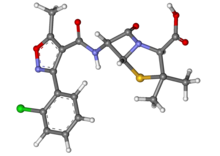Cloxacillin
 |
|
 |
|
| Clinical data | |
|---|---|
| Trade names | Cloxapen, others |
| AHFS/Drugs.com | Micromedex Detailed Consumer Information |
| Pregnancy category |
|
| Routes of administration |
by mouth, IM |
| ATC code | |
| Pharmacokinetic data | |
| Bioavailability | 37 to 90% |
| Protein binding | 95% |
| Biological half-life | 30 minutes to 1 hour |
| Excretion | kidney and biliary |
| Identifiers | |
|
|
| CAS Number | |
| PubChem CID | |
| DrugBank | |
| ChemSpider | |
| UNII | |
| KEGG | |
| ChEBI | |
| ChEMBL | |
| ECHA InfoCard | 100.000.468 |
| Chemical and physical data | |
| Formula | C19H18ClN3O5S |
| Molar mass | 435.88 g/mol |
| 3D model (Jmol) | |
|
|
|
|
Cloxacillin is an antibiotic useful for the treatment of a number of bacterial infections. This includes impetigo, cellulitis, pneumonia, septic arthritis, and otitis externa. It is not effective for Methicillin-resistant Staphylococcus aureus (MRSA). It is used by mouth and by injection.
Side effects include nausea, diarrhea, and allergic reactions including anaphylaxis.Clostridium difficile diarrhea may also occur. It is not recommended in people who have previously had a penicillin allergy. Use during pregnancy appears to be relatively safe. Cloxacillin is in the penicillin family of medications.
Cloxacillin was patented in 1960 and approved for medical use in 1965. It is on the World Health Organization's List of Essential Medicines, the most effective and safe medicines needed in a health system. The wholesale cost in the developing world is about 0.16 USD per day for the pills. It is not commercially available in the United States.
It is semisynthetic and in the same class as penicillin. Cloxacillin is used against staphylococci that produce beta-lactamase, due to its large R chain, which does not allow the beta-lactamases to bind. This drug has a weaker antibacterial activity than benzylpenicillin, and is devoid of serious toxicity except for allergic reactions.
...
Wikipedia
